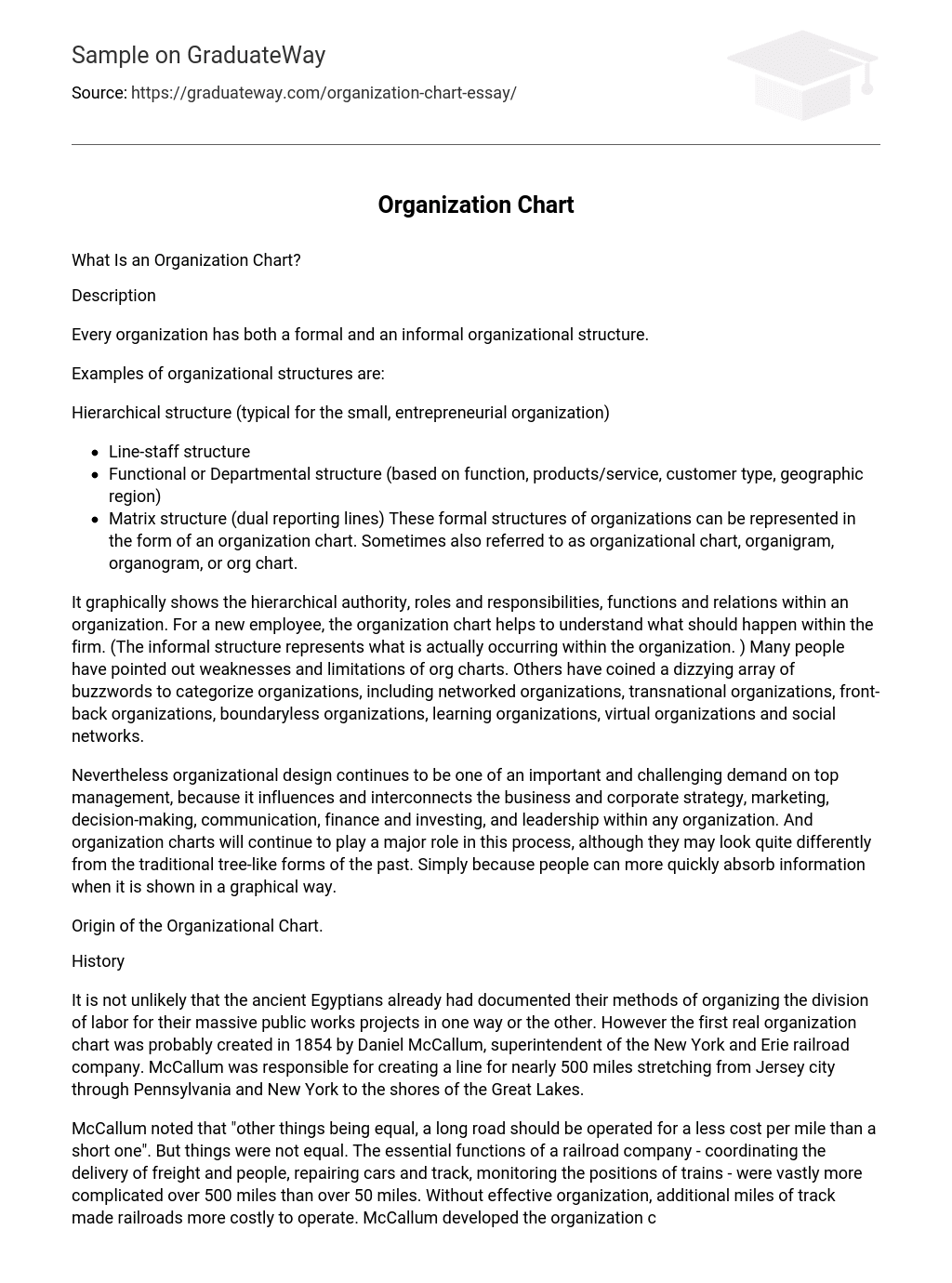What Is an Organization Chart?
Description
Every organization has both a formal and an informal organizational structure.
Examples of organizational structures are:
Hierarchical structure (typical for the small, entrepreneurial organization)
- Line-staff structure
- Functional or Departmental structure (based on function, products/service, customer type, geographic region)
- Matrix structure (dual reporting lines) These formal structures of organizations can be represented in the form of an organization chart. Sometimes also referred to as organizational chart, organigram, organogram, or org chart.
It graphically shows the hierarchical authority, roles and responsibilities, functions and relations within an organization. For a new employee, the organization chart helps to understand what should happen within the firm. (The informal structure represents what is actually occurring within the organization. ) Many people have pointed out weaknesses and limitations of org charts. Others have coined a dizzying array of buzzwords to categorize organizations, including networked organizations, transnational organizations, front-back organizations, boundaryless organizations, learning organizations, virtual organizations and social networks.
Nevertheless organizational design continues to be one of an important and challenging demand on top management, because it influences and interconnects the business and corporate strategy, marketing, decision-making, communication, finance and investing, and leadership within any organization. And organization charts will continue to play a major role in this process, although they may look quite differently from the traditional tree-like forms of the past. Simply because people can more quickly absorb information when it is shown in a graphical way.
Origin of the Organizational Chart.
History
It is not unlikely that the ancient Egyptians already had documented their methods of organizing the division of labor for their massive public works projects in one way or the other. However the first real organization chart was probably created in 1854 by Daniel McCallum, superintendent of the New York and Erie railroad company. McCallum was responsible for creating a line for nearly 500 miles stretching from Jersey city through Pennsylvania and New York to the shores of the Great Lakes.
McCallum noted that “other things being equal, a long road should be operated for a less cost per mile than a short one”. But things were not equal. The essential functions of a railroad company – coordinating the delivery of freight and people, repairing cars and track, monitoring the positions of trains – were vastly more complicated over 500 miles than over 50 miles. Without effective organization, additional miles of track made railroads more costly to operate. McCallum developed the organization chart, which according to writer Henry Varnum Poor resembled a tree.
Its roots represented the president and the board of directors. Its branches were the five operating divisions and the passenger and freight departments. Its leaves indicated the various local ticket and freight agents, crews and foremen, and so on. Historically, the organization chart is a symbol of the evolution of Western industry from being fundamentally personal in nature to enterprises in which the creation of organizational capabilities became a prerequisite for survival.
Usage of the Organization Chart
- Applications
- Defining the roles and responsibilities of all personnel within the organization.
- Establishing a hierarchical structure of authority, power and, hence, decision-making.
- Establish communication channels and information flows, incorporating a chain of command with specific rules and regulations relating to reporting procedures and accountability methods.
- Establishing control mechanisms, such as the degree of centralization and the span of control. Compare: Centralization and Decentralization. Establishing strategies for co-ordination of work practices.
- Establishing decision-making processes.
- Establishing specific operational functions and tasks.
Creating an Organizational Chart
Process
- Robert Simons (Levers of Organization Design, 2005) suggests that there are four main tensions or levers underlying any organization design:
- Strategy (structure follows strategy) versus Structure (organization design influences future strategies)
- Accountability (for today’s goals) versus Adaptability (to future changes)
- Ladders (vertical hierarchies) versus Rings (horizontal networks)
- Self-Interest (individual) versus Mission Success (department, business unit, corporation).
Compare also: Greiner, Growth Phases and Simons, Levers of Control.
Strengths of the Organization Chart
Benefits
Transparent and predictable. Helps to understand what should happen within the firm.
Provides a quick snapshot about the formal hierarchy in an organization.
Who is in charge of what. Who reports to who.
Limitations of Organizational Charts
Disadvantages
Static and inflexible. Organizations change and go through Growth Phases.
Does not help much to understand what actually happens within the informal organization. In reality, organization often behave quite chaotic and follow complex guesswork and amplification mechanisms (Core Group Theory).
Traditional org charts can not cope with changing boundaries of firms due to Outsourcing, Information Technology, Strategic Alliances, and the Network Economy.





